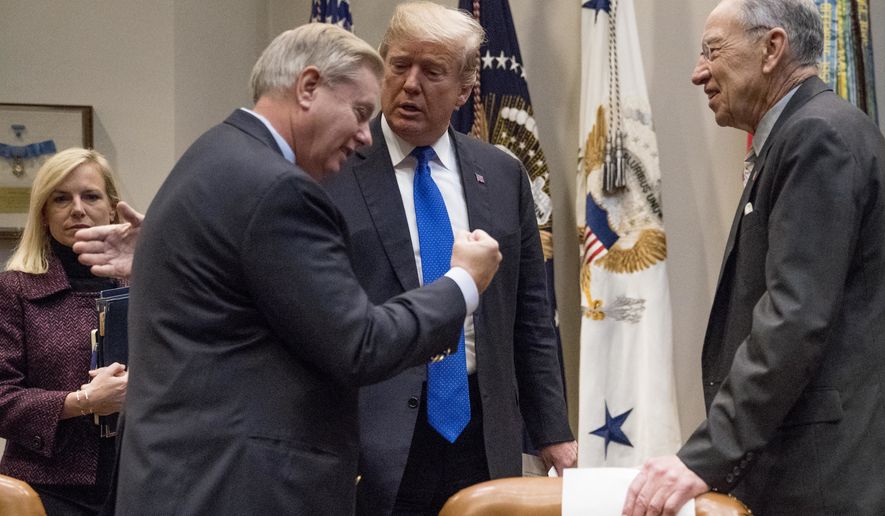The immigration proposal senators presented to President Trump on Thursday fell far short of what the president has said is needed for him to sign a bill, offering only a small downpayment on the border fence and just a small dent in the chain of family migration.
Sources familiar with the bill said it would offer a generous pathway to citizenship for illegal immigrant Dreamers that goes well beyond just the 700,000 people currently protected under the Obama-era DACA deportation amnesty.
The proposal also eliminates the Diversity Visa Lottery, as Mr. Trump demanded — but it uses those visas to create a new amnesty for hundreds of thousands of other would-be illegal immigrants from Haiti, El Salvador and other countries who have suffered from natural disasters and have been living in the U.S. under Temporary Protected Status.
The plan was worked out by Sens. Lindsey Graham, a Republican, and Sen. Richard Durbin, a Democrat, who led a group of six senators who’d said they would reach an agreement that could pass Congress.
“President Trump called on Congress to solve the DACA challenge. We have been working for four months and have reached an agreement in principle that addresses border security, the diversity visa lottery, chain migration/family reunification, and the Dream Act—the areas outlined by the president,” the senators said in a statement.
“We are now working to build support for that deal in Congress,” they added.
But the White House said their outline wasn’t good enough.
“There has not been a deal reached yet, however we still think we can get there,” White House press secretary Sarah Sanders said.
Groups that support stricter limits on immigration said the Graham-Durbin proposal should be a non-starter for Congress.
“This is a joke. This is not a serious proposal in any way,” said Rosemary Jenks, government relations manager at NumbersUSA.
The Graham-Durbin deal offers Mr. Trump less than 10 percent of what he is seeking on the border wall, while attaching several new conditions to construction.
The deal does cut chain migration by curtailing green card holders’ ability to sponsor their adult children for visas. That amounts to less than 3 percent of total annual immigration. The visas would be used to speed up nuclear family visas, so the total level of immigration would remain the same.
Dreamers would get a pathway to citizenship that goes well beyond the people already protected under the Obama-era program. The eligibility date would be anyone who came to the U.S. by June 15, 2012.
Perhaps the biggest change would come on the visa lottery, which Mr. Trump has called for eliminating.
The senators’ plan would nix it — but would reserve half of the 50,000 or so annual visas to go to lottery-eligible countries on a merit basis, rather than by chance. The other half of the visas would go to create a new pathway to citizenship for hundreds of thousands of people who could become illegal immigrants when their status under the humanitarian relief TPS program expires.
El Salvador accounts for more than 260,000 people in the U.S. under TPS, while Haiti and Honduras have about 50,000 each. Other countries have lesser amounts.
It was as senators were listing those nations that Mr. Trump reportedly called them “sh—hole countries” and wondered why lawmakers were pushing for more migration from there, rather than from more developed nations.
The Washington Post first reported the comment, which drew fierce condemnation from across the political spectrum.
The comments have largely overshadowed the details of the Graham-Durbin plan, with immigrant-rights advocates saying they disqualify the president from playing a deciding role in the immigration debate.
“These comments clearly reflect the president’s true feelings on immigrants and make it extremely doubtful that he will work in an honest, decent way that reflects America’s best values on legislation to protect Dreamers,” said House Minority Whip Steny H. Hoyer, Maryland Democrat.
• Stephen Dinan can be reached at sdinan@washingtontimes.com.




Please read our comment policy before commenting.